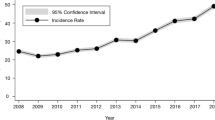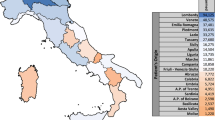Abstract
Purpose and hypothesis
Shoulder lesions are common and a challenge to diagnose. They often result in significant disability for the patient and are an economic burden to society. From recent studies, an increasing incidence has been reported. The purpose of this study was to investigate and map the incidence of shoulder lesions in Denmark from 1996 to 2013 with focus on sex, age and geographical area.
Methods
The Danish National Patient Registry was searched retrospectively to find the number of shoulder lesions in Denmark during the period 1996–2013. Regional population data were retrieved from the services of Statistics Denmark. Incidence rates were analysed using Poisson regression models, and all analyses were done in R 3.2.2, and p values less than 0.05 were considered statistically significant.
Results
During the 18-year period, 244,519 patients with a DM 75 diagnosis were registered. Male-to-female ratio was 51:49, and median age was 51. Most frequent were rotator cuff syndrome with a mean incidence rate of 313.3 (confidence interval 241.8–384.8) per 105 person-years at risk (PYRS). A statistically significant increase in overall incidence rate from 149.4 per 105 PYRS in 1996 to 715.3 per 105 PYRS in 2013 was found (p < 0.01). Incidence was highest for men aged 51–70 (1085.1 per 105 PYRS in 2013). There was no significant difference in incidence between sexes. Rural areas had a 1.4-fold higher mean incidence rate than urban areas.
Conclusion
The incidence of shoulder lesions rapidly increased mainly due to an increase among people of working age (31–70 years). There were no significant differences in incidence between sexes. Rural areas had a 1.4-fold higher incidence rate than urban areas. As shoulder lesions impose a huge socioeconomic burden on society, not to mention a great distress to the patient, the present findings is highly relevant for political decision-making regarding preventive and health promoting initiatives.




Similar content being viewed by others
References
Chiang Colvin A, Egorova N, Harrison AK, Moskowitz A, Flatow EL (2012) National trends in rotator cuff repair. J Bone Jt Surg 94:227–233
Danish Diabetes Association. The National Diabetes Register. http://www.diabetes.dk/. Accessed 22 June 2017
Gerdesmeyer L, Wagenpfeil S, Haake M, Maier M, Loew M, Gassel S (2003) Extracorporeal shock wave therapy for the treatment of chronic calcifying tendonitis of the rotator cuff. A randomized controlled trial. J Am Med Assoc 290:2573–2580
Grossschaedl F, Freidl W, Éva R (2014) A 35-year trend analysis for back pain in Austria: the role of obesity. PLoS ONE 9:1–7
Hand C, Clipsham K, Rees JL, Carr AJ, Kingdom U (2008) Long-term outcome of frozen shoulder. J Shoulder Elbow Surg 17:231–236
Hsiao MS, Cameron KL, Tucker CJ, Benigni M, Blaine TA, Owens BD (2015) Shoulder impingement in the United States military. J Shoulder Elbow Surg 24:1486–1492
Hsu JE, Anakwenze OA, Warrender WJ, Abboud JA (2011) Current review of adhesive capsulitis. J Shoulder Elbow Surg 20:502–514
Judge A, Murphy RJ, Maxwell R, Arden NK, Carr AJ (2014) Temporal trends and geographical variation in the use of subacromial decompression and rotator cuff repair of the shoulder in England. Bone Jt J 96:70–74
Kjøller M, Juel K, F K-J (2007) Folkesundhedsrapporten Danmark
Longo UG, Loppini M, Marineo G, Khan WS, Maffulli N, Denaro V (2011) Tendinopathy of the tendon of the long head of the biceps. Sport Med Arthrosc Rev 19:321–332
Miranda H, Punnett L, Viikari-Juntura E, Heliövaara M, Knekt P (2008) Physical work and chronic shoulder disorder. Results of a prospective population-based study. Ann Rheum Dis 67:218–223
Neer CS (1983) Impingement lesions. Clin Orthop Relat Res 173:70–77
Neviaser AS, Hannafin JA (2010) Adhesive capsulitis: a review of current treatment. Am J Sports Med 38:2346–2356
Nickelsen Nahne T (2002) Datavaliditet og dækningsgrad i Landspatientregisteret. Ugeskr Laeger 164:33–37
Ostör AJK, Richards CA, Prevost AT, Speed CA, Hazleman BL (2005) Diagnosis and relation to general health of shoulder disorders presenting to primary care. Rheumatol (Oxford) 44:800–805
Pascarelli EF, Hsu Y (2001) Understanding work-related upper extremity disorders: clinical findings in 485 computer users, musicians, and others. J Occup Rehabil 11:1–21
Rangan A, Goodchild L, Gibson J, Brownson P, Thomas M, Rees J, Kulkarni R (2015) BESS/BOA patient care pathways frozen shoulder. Shoulder Elbow 7:299–307
Robinson CM, Seah KTM, Chee YH, Hindle P, Murray IR, Chee YH (2012) Frozen shoulder. J Bone Jt Surg Br 9494:1–9
Russell S, Jariwala A, Conlon R, Selfe J, Richards J, Walton M (2014) A blinded, randomized, controlled trial assessing conservative management strategies for frozen shoulder. J Shoulder Elbow Surg Elsevier Ltd 23:500–507
Schmidt M, Schmidt S, Sandegaard J, Eherenstein V, Pedersen L, Sørensen HT (2015) The Danish National Patient Registry: a review of content, data quality, and research potential. Clin Epidemiol 4:449–490 (In Press)
Seida JC, Leblanc C, Schouten JR, Mousavi SS, Hartling L, Vandermeer B, Tjosvold L, Sheps DM (2010) Systematic review: nonoperative and operative treatments for rotator cuff tears. Ann Intern Med 153:246–255
Seitz AL, Mcclure PW, Finucane S, Douglas N, Iii B, Michener LA (2011) Mechanisms of rotator cuff tendinopathy: intrinsic, extrinsic, or both? ☆. JCLB 26:1–12
Shanahan EM (2016) Shoulder pain at the workplace. Best Pract Res Clin Rheumatol Elsevier Ltd 25:59–68
Smith R (2001) The cost of shoulder pain at work. Br Med J 322:64–65
Stäbler MMA, Lienemann CSA (2001) On the impact of calcified deposits within the rotator cuff tendons in shoulders of patients with shoulder pain and dysfunction. Arch Orthop Trauma Surg 121:371–378
Statistics Denmark Statbank Denmark
Sundhedsstyrelsen (2013) NKR for diagnostik og behandling af patienter med udvalgte skulderlidelser
Sundhedsstyrelsen S og B (2011) Impingementsyndrom/rotator cuff-syndrom og traumatisk rotator cuff-ruptur Del 2: Faglige visitationsretningslinjer
van der Windt DA, Koes BW, de Jong BA, Bouter LM (1995) Shoulder disorders in general practice: incidence, patient characteristics, and management. Ann Rheum Dis Rheum Dis 54:959–964
Author information
Authors and Affiliations
Contributions
All authors have participated in conception and design of the study as well as revising the manuscript critically. NM is responsible for acquisition and interpretation of data and drafting the manuscript. TK is responsible for all data handling and statistical analyses. KWB was involved in and overall responsible for all phases of the study. All authors are accountable for all aspects of the work in ensuring that questions related to the accuracy or integrity of any part of the work are appropriately investigated and resolved. All authors have read and approved the manuscript.
Corresponding author
Ethics declarations
Conflict of interest
The authors declare that they have no conflict of interest in relation to the present study.
Funding
This study did not recieve any fundings.
Ethical approval
The study was approved by the Danish Data Protection Agency. According to Danish legislation, no IRB approval was needed, as the study is a retrospective registry study.
Informed Consent
No written consent is necessary for national databases in Denmark.
Rights and permissions
About this article
Cite this article
Monrad, N., Ganestam, A., Kallemose, T. et al. Alarming increase in the registration of degenerative rotator cuff-related lesions a nationwide epidemiological study investigating 244,519 patients. Knee Surg Sports Traumatol Arthrosc 26, 188–194 (2018). https://doi.org/10.1007/s00167-017-4626-3
Received:
Accepted:
Published:
Issue Date:
DOI: https://doi.org/10.1007/s00167-017-4626-3




